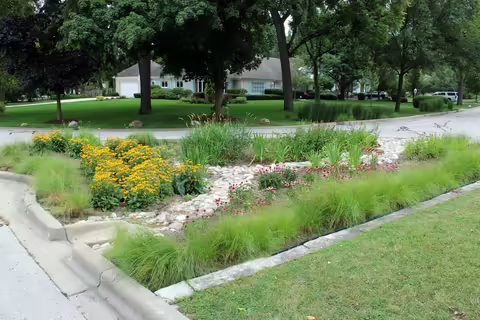
Rain gardens are bowl-shaped landscape features that capture and absorb rainfall and snowmelt. These nature-based solutions can help to reduce local flooding issues while improving downstream water quality and recharging groundwater. They also provide a variety of other benefits, like habitat creation for wildlife and carbon sequestration.
They are relevant today with rising stormwater management challenges affecting lakes and rivers, increased urbanization, and a growing awareness of sustainable practices for better-prepared communities.
Rain gardens help local waterways
When it rains, water falls on hard surfaces like roads, roofs, and sidewalks. As explained in a recent Everyday Environment blog by Illinois Extension Water Quality and Stormwater Specialist Eliana Brown, this water picks up pollution like motor oil, excess nutrients, and pet waste. The polluted water then flows into storm drains, which lead to rivers and lakes. This can cause problems like harmful algal blooms and damage to habitats for fish and other animals. A rain garden is a helpful solution. It collects and absorbs rainwater, letting it soak into the ground. This helps prevent flooding, reduces pollution, and supports plants and animals native to the area.
How do native plants support rain gardens and biodiversity?
Native plants often take center stage in rain gardens and for good reason. Their deep root systems stabilize soil, improve water infiltration, and adapt to extreme weather conditions like drought and heavy rain. Beyond their functionality, these plants attract pollinators, birds, and other wildlife. Species such as milkweed support monarch butterflies, while native grasses like switchgrass create year-round garden structure and habitat. Together, these plants turn rain gardens into ecological hotspots.
Rain gardens can boost community disaster preparedness
Rain gardens aren't just for individual yards, they can improve flood resistance for entire neighborhoods. Some communities have installed rain gardens and other forms of green stormwater infrastructure along streets to reduce flash flooding, beautify public spaces, and support wildlife corridors. For example, in one Illinois community, a network of rain gardens significantly reduced flood events by creating pollinator-friendly green spaces.
Tips for designing a rain garden
The basics of rain garden design
Position your rain garden downhill from impermeable surfaces and at least 10 feet from foundations. It should intercept water naturally flowing during rainstorms. The garden’s size depends on the amount of impermeable space draining into it. Test your soil’s infiltration rate and ensure water drains within 24–48 hours, amending the soil with sand and compost if necessary.
There are layers of planting design
Rain gardens are not always wet. They feature zones of varying moisture levels:
- Basin: Moisture-loving plants like palm sedge or blue flag iris thrive here.
- Slopes: Plants have to tolerate periods of stormwater inundation and drought.
- Banks: Drought-tolerant species such as purple coneflower or black-eyed Susan are ideal for these drier areas.
Consider planting a plant community that mimics natural systems
- Groundcovers: Densely planted, low-growing species create a living "green mulch" that suppresses weeds, improves soil health, and enhances stormwater infiltration.
- Seasonal: Features plant species that are visually dominant for a period of time, such as black-eyed Susan and purple coneflower.
- Structural: Includes larger species or species with architecturally unique structure that provides year-round interest, such as shrubs and tall grasses.
Thoughtful plant selection and strategic design can help your garden mimic natural ecosystems, reducing long-term maintenance needs while boosting aesthetics and biodiversity. Begin with a few hardy native species well-suited to your conditions, then gradually expand your plant selection to increase biodiversity and visual appeal.
How do I get started?
- Rainscaping Education Program: Offers training on rain garden planning and maintenance. Visit go.illinois.edu/RainscapingEducation and check with your local Extension office about upcoming programs.
- Red Oak Rain Garden: Visit RedOakRainGarden.org for tips and inspiration.
- Brochure Series: Explore a number of native plant garden guides that utilize Red Oak Rain Garden plant species, planting techniques, and lessons learned at go.illinois.edu/RORGResources
- Illinois Groundwork Plant Finder: Use our filterable tool to identify plants that will work for your rain garden at go.illinois.edu/PlantFinder
Thank you for reading!
Everyday Environment is a series of blogs, podcasts, webinars and videos on exploring the intricate web of connections that tie us to the natural world. Want to listen to us chat about this topic? Check out the podcast episode on this topic to hear more from the Everyday Environment team about creating rain gardens.
Listen to the Podcast Sign Up for Everyday Environment Newsletter


